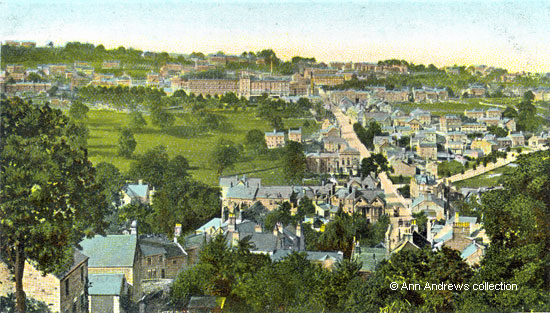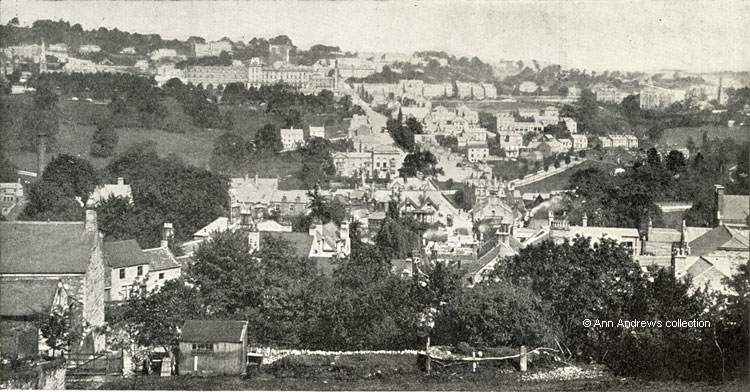|
Images Index> Matlock, 20th and 21st Century Images> This page |
| Matlock Bank & Bridge, 1900-02 |
| Matlock : Twentieth Century Photographs, Postcards, Engravings & Etchings |
|
 The second image was published in this Guide.
|
|||||||||||||
Bridge House (later Bridge Hall Hydro), which was described in 1893 as "having an attractive villa like appearance", was extended in 1899-1900 and by this time was being used as the Town Hall and the Council Offices. Various concerts and shows were also staged in the building. For example, in the spring of 1902 a Mr. Joshua Dyson together with his original Diorama and Gipsy Choir visited Matlock for nine days. It was their first visit to Matlock and the programme promised something different for every recital from the choir of 20 performers[1]. Another entertainer to perform there later the same year was Mr. Mel. B. Spurr who gave a "humourous and musical recital", though it seems his efforts were only appreciated by a small audience![2] Plots of land for building would be offered for sale from time to time and in 1902 Joseph Hodgkinson advertised a plot "situate in Limegrove Walk No. 1, Matlock Bridge, being Lot 27 on the Matlock Bridge Land Society's Estate Plan, containing 533 square yards or thereabouts". The land did not sell on that occasion so the land was not developed[3]. This was followed by a important sale of property from Charles Rowland's estate. Six freehold houses and shops with frontages onto Bank Road and Oak Road were sold to Mr. George Bunting; Oak Terrace on Matlock Bank was also purchased by Mr. Bunting. Five cottages (Carlton Terrace) and four more (Moyston Terrace) were bought by Dr. Le Page. Pope Carr Gardens, with a cottage and greenhouses and occupied by James Greaves at the time, were bought by a Mr. Sheridan of Sheffield[4]. In December 1902 there was an incident on the Bank that could have been considerably worse than it turned out to be. A pantechnicon had been sent to Matlock Station from a Leicestershire firm, laden with furniture for Rockside Hydro and the goods were successfully conveyed to their destination by the rail company's dray. Having delivered the items to the Hydro without any problems, the dray began the return journey down Bank Road via Rutland Street. Unfortunately the horse took exception to a stationary tram and shied, then started to trot down the hill but rapidly began to gallop. The unfortunate animal careered into a lamp post between Matlock House Hydro and Hands Garage and the lamp post snapped! The horse continued on but after several other incidents it unfortunately sustained fatal injuries. It was lucky no people were injured as Smedley's bus was going up Bank Road at the time, but managed to avoid a collision[5].
Initially it was thought the two black and white pictures were two different images, but on close examination it has been found that the postcard is actually just a cropped version of the picture from the Guide. There are several small details that prove this. Firstly, the people surrounding the tram are exactly the same in both pictures[6]; secondly, there is another tram outside the Matlock Methodist and United Reformed Church on Bank Road; and thirdly, the chimney smoke rising from both one of the Dale Road shops and another building to the left of the County Bridge in the foreground is also the same. All three things would not be identical if two pictures had been taken from the same location at different times. |
||||||||||||||
|
||||||||||||||
|
||||||||||||||
1. "Matlock Bridge and Bank from Masson". One of the Reliable Series, W R & S, No.5122. Chromotyped in Hessen. Not used. © Ann Andrews collection 2. "Matlock Bank" published by Photochrom Co. Ltd., London posted 10 Sep 1910 in Matlock Bath to Miss Butler, Leamington Spa from J. B. Morral. In the collection of provided by and © Pauline Jordan. 3. Photograph of "Matlock Bank" published by the Photochrom Co., Ltd., London. From Ward Lock & Co's "Guide to Matlock, Dovedale, Etc.", Illustrated Guide Books of England and Wales (Guide Series 1903-4) © Ann Andrews collection. This image was originally on matlock_bank_01_wl1903.htm but the two pages have now been merged. Images scanned for this website and information researched, written by and © Ann Andrews. Intended for personal use only. |
||||||||||||||
References (coloured links are to transcripts and information elsewhere on this web site): [1] "Derbyshire Times", 17 May 1902 (Matlock Bridge. Dyson's Gipsy Choir). Mr. Dyson toured the country for many years and died at Wetherby in October 1910. [2] "Derbyshire Times", 11 October 1902. He was about to embark on a prolonged tour of America. [3] "Derbyshire Times", 10 May 1902. The plot was auctioned at the Old English Hotel by Joseph Hodgkinson on 14 May 1902 but failed to its reserve and was withdrawn. [4] "Derbyshire Times",
21 May 1902 and "Derbyshire
Times", 31 May 1902. The occupiers were: [5] "Derbyshire Times", 6 December 1902. [6] See Bank Road & the Steep-Gradient Tramway [7] There is more about the Chapel - United Methodist Free Chapel, Smedley's Hydro, Matlock, 1885 [8] 1893 auction notice. There
are several other images of the former colour works and
its chimney on the site: The
Popular Album of Matlock is a late 19th century booklet
and the chimney is coloured red on Matlock
- looking towards Hackney, early 20th Century | Holt
Lane and Dale Road, about 1900. You have
to look hard, but it also can be seen on Matlock
Bank, the Hall Leys and Dale Road, 1912-14 (top image). |
||||||||||||||






